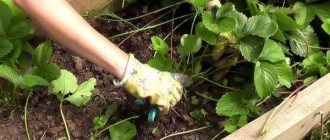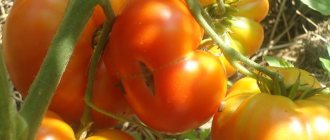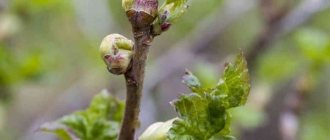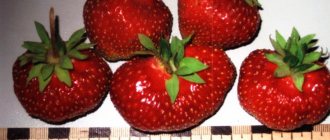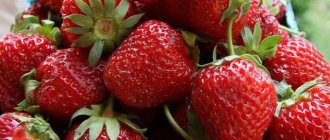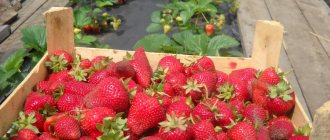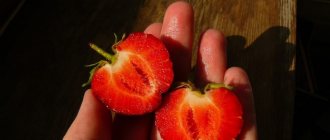Most recently, we praised the famous American strawberry variety Albion. Indeed, this plant managed to gain popularity not only in its homeland, but also abroad in a short period of time. Today we would like to talk about another American representative, the San Andreas strawberry variety. It is not far from Albion, since it has its genetic code in its structure. And many gardeners jokingly call it Albion version 2.0.
In this article we will present a detailed description of the variety, show photos, and reviews of those who have become acquainted with the berries of this strawberry.
History of the development of San Andreas strawberries
Strawberries of this variety were bred by American scientists Douglas W. Shaw and Kirk D. Larson. During the breeding process, these specialists crossed the Albion variety and the numbered variety Cal 97.86-1. These works were carried out at the end of the last century and were completed in 2001. The new strawberry received the conditional number Cal 1.139-2,
it was planted at a test site at the University of California (Winters), where experimental cultivation of the variety was carried out. The next season, the first fruits of the new strawberries were obtained, and these strawberries were also propagated by rosettes that appeared on the tendrils of the berry bushes.
Photo of San Andreas strawberries
Subsequently, this variety was assigned the number CN223, and subsequently, when selling seedlings of new remontant strawberries, it was already called San Andreas.
In 2005, the San Andreas variety underwent further tests at the Watsonville Research Center, where scientists were convinced that the varietal qualities of strawberries were preserved in its “offspring.”
As a result, in 2008, a patent was issued to the remontant San Andreas strawberry, valid until 2028.
Harvesting and processing
The harvest ripens in June, namely 5-7 weeks after flowering. When overripe, the berries continue to retain their shape and the pulp does not soften. And yet, it is not recommended to delay harvesting too much, since when the berries are overripe, they may begin to lose their taste, marketability and transportability. In addition, overripe strawberries do not last long. The berries ripen together. These strawberries can be harvested from June to mid-autumn, so the berries are harvested approximately once every 3-7 days, as they ripen.
Important!
In order for strawberries to get sick less often and bear fruit well, it is necessary to regularly pick or cut off all dry, damaged leaves from the bushes.
San Andreas strawberries make delicious juice, compotes, jams, and in jam the berries retain their shape and do not fall apart
Fresh strawberries do not last long. It can lie for about 2 weeks without spoiling if it is collected in time, but then it begins to rapidly deteriorate. You can eat this variety of strawberries fresh. It is also suitable for freezing, drying or canning. It produces delicious juice, compotes, jams, and in jam the berries retain their shape and do not fall apart.
Characteristics and description
The bushes of this variety are strong and powerful, up to 25 cm high and about 30 cm in diameter. The bushes are quite leafy and compact. The foliage is large, with moderate pubescence, with an average number of small teeth along the edges. At the beginning of the season, the color of the foliage is more saturated than at the end, rich emerald. The peduncles of this variety are strong and strong, growing higher than the foliage. They hold the berries starting to ripen well, but gradually sink under their weight. At the same time, up to 10 peduncles can appear on the bushes, each of which produces up to 5-7 flowers.
Photo of San Andreas strawberry pulp
The number of tendrils formed on San Andreas strawberry bushes is average, the rosettes grow large, take root well and quickly. Most often, there is no need to remove excess whiskers, which makes caring for this strawberry plantation much easier.
Ripe fruits of this variety are distinguished by sweetness, a small amount of acid and a strong strawberry aroma. Tasters say that the berries of this variety are close in taste to their “parent” - the Albion variety, but are somewhat inferior in taste, which are less rich. The pulp of San Andreas is less compacted, juicier than Albion berries, with a strong and elastic skin.
Strawberry San Andreas - video
The ripe berries of this variety are very beautiful, approximately equal in size, with a characteristic glossy shine, with small yellow seeds slightly pressed into the skin. In general, the berries are of medium size, weighing up to 30 g, but with good care, the first harvested fruits can weigh 45-50 g or more. The same large berries can be harvested in the second wave of harvest in September. The color of the skin is a rich, bright ruby color, with an orange tint.
The berries are of a characteristic cone shape with a blunt “spout”. During the harvest process, most of the fruits are of good quality - more than 92%.
EXCELLENT VARIETY OF STRAWBERRY!
Strawberries Asia
During the harvest period - in the first and second waves - about 80% of the berries are the same size. The fruits are about 5-6 cm long, 4 cm wide, and the length-to-width ratio is 1.3.
The pulp has practically no voids, its color is orange-pink. The taste of strawberries is equally high throughout the entire fruiting period. Even slightly unripe fruits have a pleasant taste despite the greenish color of the berries.
On a note!
Even during rainy periods or slight cooling, the taste of ripe San Andreas strawberries does not deteriorate.
Photo of San Andreas strawberry bushes
The berries come off the stems well without releasing any juice. The harvested crop can be transported to any distance; ripe fruits can be stored for quite a long time after harvesting (not even in the refrigerator).
Ripe fruits are used for fresh consumption, added to desserts, and the harvested crop is also preserved - preserves and jams are made, frozen for the winter, and sealed in aromatic sweet compotes.
The root system of this variety is well developed, so it better tolerates periods of drought and severe cold, and is practically not subject to freezing even without shelter during winter frosts, withstanding cold snaps down to -20-22 degrees Celsius.
This variety of strawberries is grown in open ground beds in the garden, and is also used for planting on an industrial scale.
Preparing for landing
To grow a new strawberry, it is important to choose the right site and improve it. Prepare the soil. Find a nursery where you can buy good seedlings.
Landing place
Select a sunny, flat area - a southern or western slope. Wet lowlands should be avoided. Areas exposed to all winds are not suitable.
A soil mixture is prepared for the beds, adding compost (humus) and peat to the soil for looseness and moisture permeability.
On poor soils, complex mineral fertilizers intended for strawberries are applied. “San Andreas” has low soil requirements, but traditionally they try to ensure that the site is well prepared and fertilized.
It has good growth when planted in an area where the predecessors were radishes, carrots, mustard, parsley, and garlic. Undesirable predecessors are cucumbers, nightshades and cabbage.
Selection of seedlings
When purchasing, it is important to pay attention to the condition of the seedlings. They should be:
- with three leaves;
- well-developed root system (open or closed);
- the presence of an apical growth bud;
- free from spots or other leaf defects;
- strong, without signs of withering.
The variety bears fruit in the first year of cultivation, but the flower stalks are cut off so that the San Andreas garden strawberry gets stronger and bears fruit abundantly in the future.
Landing
Planting pattern:
- row spacing – 40 cm;
- between plants – 30 cm.
Bushes are planted in the fall, in September, 3–4 weeks before the first frost. For the winter, fragile plants are mulched with peat or humus. The preferred option is planting in July. In this case, the strawberries will not only get stronger, but will also lay flower buds to bring the first harvest next year.
Step-by-step instructions for correct landing:
- Leave 2-3 leaves on the bush and trim the root system. If the roots are dry, then before planting they are dipped in a clay mash.
- Dig holes according to the diagram and water well.
- The seedling is lowered into the hole and the roots are straightened. They bury it with earth so that the central heart remains on the surface.
- Water again and mulch with peat (straw, sawdust, humus).
In greenhouses or on the balcony, the vertical growing method is practiced. Strawberries "San Andreas" are planted in pots or boxes, creating support for growth. This method saves space, but requires additional care: more frequent watering and fertilizing.
Strawberry variety yield
Since this variety bears fruit several times per season, the total yield per season from each San Andreas bush is at least 3.2 kg. But such indicators were achieved when growing the variety in California, where winters are very mild and frosts practically never occur. In addition, fertilizing was applied weekly to the bushes of this strawberry, which is why the yield turned out to be so high. Russian gardeners are unlikely to “feed” strawberries with fertilizers so often, and then use the fruits “stuffed” with fertilizers for food.
Therefore, in Russia, the yield indicators of the San Andreas variety are much more modest - 0.9-1.1 kg of berries from each bush.
Care
After planting, it is important to create favorable conditions for the growth of berries. In order for the seedling to bear fruit better in subsequent years, in the first year it is advised to remove all flowers, then all efforts will be directed to rooting and developing the strength of the plant.
Loosening
In order for strawberries to grow well, it is necessary that the soil does not coke and is sufficiently drained. To achieve this, it is necessary to periodically loosen the soil.
Watering
For strawberries, oversaturation with moisture and aridity are equally harmful . The first causes rot, but the second causes the plant to simply dry out. To avoid this, you can use a drip irrigation system. In dry times, watering is applied once every 3-4 days.
Pest Control
San Andreas is a variety that is not so easy to attack by pests and various diseases. But it’s still better to prevent the possibility of infection. It helps to avoid epidemics by growing garlic, calendula, dill or parsley near strawberries. Good drainage and timely removal of weeds and leaf clusters also
After harvesting, the beds are treated with 1% Bordeaux mixture . This allows you to overwinter without infections and overwintering larvae. During flowering and ripening of the crop, chemical treatment is not allowed.
Mulching
The San Andreas variety responds positively to mulching. Mulching can be done in a variety of ways. For example, straw or spruce branches , although the branches at the decomposition stage will add a little acidity to the soil; you can also use agrofibre or any known methods.
Fertilizer application
Naturally, a large variety of strawberries needs more feeding, as it is capable of pumping out more fertilizer from the soil. What can you fertilize with:
- At the beginning of the season, nitrogen fertilizers are used to help the formation of green mass.
- At the end of spring, the plants are watered with a solution of water and mullein or bird droppings.
- Complex fertilizers are used at the beginning of abundant flowering, nitrogen phosphorus, etc., you can use ash.
- Once the season is over, fallen leaves are an ideal fertilizer.
Feeding must begin in the second year of the plant’s life.
Trimming tendrils and leaves
Due to the fact that the growth of the mustache of the San Andreas variety is small, they will rarely have to be trimmed. When collecting mustaches for propagating bushes, it is important to cut off the mustache of a new order , they will be the strongest.
Feeding during the growing season
It is best to treat with organic substances:
- To increase the nutritional value of the soil, you can use chicken manure.
- To extend the fruiting time and start growth, ash is suitable.
- To reduce the percentage of empty blooms, boric acid is used.
- If you need to increase the endurance of plants, use yeast.
- To reduce pest attacks, you can use iodine.
Preparing bushes for wintering
In the south, the San Andreas variety will do without shelter. The declared frost resistance of -25 C has already been tested experimentally by gardeners.
In the Moscow region and in the north of the country, the beds are mulched with compost, leaves, covered with spruce branches, and arcs are installed for agrofibre. During the thaw period, strawberries are opened to prevent the bushes from rotting.
Reproduction
The San Andreas variety is quite susceptible to propagation by division .
The only problem is that you need to get the hang of it in order to be able to separate the desired part of the bush with a sufficient amount of young root, then the transplant will be successful. It is important for the first time to plant the shoot in a separate cup with its own soil, so the plant will not get sick. It is important to propagate bushes with the largest offspring.
Reproduction using seeds is unprofitable for several reasons. Firstly, this is quite troublesome, and without proper experience it will be almost impossible to do. Secondly, part of the DNA of the berry may change, and it will become, for example, less sweet or smaller.
Diseases and pests
The San Andreas variety has a fairly high resistance to most diseases characteristic of other varieties of this berry crop, and is practically not attacked by mites.
So, the variety is practically not susceptible to:
- powdery mildew;
- anthracnose;
- verticillium wilt;
- late blight;
- leaf spotting.
This berry crop is also tolerant to strawberry viruses common in the American states.
Difficulties in growing and care recommendations
San Andreas is a remontant large-fruited variety, so to achieve high yields it requires competent agricultural technology. Regular provision of moisture, spraying and watering with fertilizer solutions under the roots and along the leaves. Plus preventive treatments against diseases and pests and soil mulching. There are no special problems when cultivating this strawberry.
Advantages
The main advantages of San Andrian strawberries include:
- excellent fruiting;
- good taste and excellent appearance, yield when picking first-class strawberries is above 90%;
- high shelf life of collected fruits even without a refrigerator;
- approximately the same size of fruits;
- ripe berries can be transported to different distances without loss of commercial quality and taste;
- the versatility of ripe strawberries;
- San Andreas tolerates short periods of drought and cold down to -20 degrees Celsius;
- The variety is resistant to most diseases characteristic of other strawberry varieties.
Strawberry San Andreas and its potential - video
This variety has no particular disadvantages.
But it should be noted that, like all remontant varieties, San Andreas needs frequent feeding, otherwise there will not be a high yield, and the berries will become smaller. We also have to renew this strawberry plantation annually, since in the second season the San Andreas bushes have less strength to grow and bear fruit, so the berries will be smaller, and weakened plants may be susceptible to diseases.
Disadvantages of the variety
The variety also has disadvantages. When growing, gardeners often note them. But how significant they are, each gardener decides for himself.
- San Andreas strawberries produce large yields for about 3 years, then the bushes need to be replaced with new ones.
- The bushes are resistant to frost down to -16 degrees.
- Despite their resistance to drought, it is not recommended to forget about watering strawberries, since a lack of water always affects the size and taste of the berries.
Interesting!
A sharp increase in temperatures negatively affects yields. In order for the bushes to continue to bear fruit normally without slowing down, it is necessary to darken them from the sun on hot days from July to August.
Another significant drawback noted by gardeners is that the variety is not suitable for growing in open ground if the climate is not hot. So you can’t do without a greenhouse.
One significant drawback noted by gardeners is that the variety is not suitable for growing in open ground.
Strawberry San Andreas: growing features, planting and care
It's no secret that if you follow agrotechnical cultivation rules, you can significantly increase the yield of a strawberry plantation.
Remontant strawberry cultivation. Features of care - video
Landing
It is better to plant these strawberries in sandy or loamy soils where moisture does not stagnate. The soil should be loose, fertile, with neutral acidity, and the area should be well lit by sunlight.
Photo of planting strawberries
The distance between seedlings in rows should be about 0.3 m, and the row spacing should be about 0.6-0.8 m. The strip method of planting strawberries is also common, in which two rows of strawberries are planted in a bed with a distance between bushes of 0. 3 m, and between lines also 0.3 m. And between adjacent ridges you need to retreat 0.65-0.7 m.
BERRY:
Honeysuckle Nymph Blueberry Elizabeth
Fruit harvesting and storage rules
In the summer months, strawberry fruits are collected in the early morning hours or in the evening, when solar activity has already subsided. Berries picked in the heat are worse in taste and quality and spoil faster. When picking in early spring or autumn, on the contrary, it is advisable to pick the berries when the sun's rays heat them, drying the morning dew from the fruit.
Berries are collected in plastic booties (1 and 0.5 kilograms) or small, flat cardboard boxes with a capacity of up to 5 kilograms. In this case, transportability and keeping quality will be maximum. After harvesting, it is advisable to cool the fruits, if possible. This procedure further increases the commercial characteristics of strawberries during subsequent transportation.
Further care
Further care for San Andreas strawberry bushes consists of regular watering, fertilizing, removing weeds and loosening the rows.
Watering should be carried out as the top layer of soil dries. After each watering, you should carefully loosen the surrounding area and remove weeds from the beds and between the rows.
As the tendrils form, the beds should be prepared for the autumn planting of new plants to ensure a good harvest next season.
Top dressing
The bushes of the variety should be fed at least once every 2-2.5 weeks, applying complex mineral fertilizers to the berry garden. You can also fertilize plants with humus or compost, alternating the application of organic matter and mineral fertilizers.
Photo of fertilizing for strawberries
Important!
You cannot apply fresh manure under strawberry bushes - it can burn the delicate root system, and the fruits will be bitter.
Preparing for winter
If winters in the region are not cold, and the temperature does not drop below -15 degrees, then these strawberries do not need to be covered for the winter - just come and throw more snow on the beds.
Photo of covering strawberries with lutrasil
In regions with colder winters, lutrasil or other non-woven fabric should be stretched over the beds to protect the plantings from winter frosts.
Agricultural technology for remontant strawberries
To ensure high yields for San Andreas strawberries, you need to carefully care for them.
Watering
After planting for several days, young plants need to be watered daily, and when they become stronger, once every 3 days. Last year's bushes need to be watered for the first time at the end of April. In May and June, moisten strawberries 4 times; in August and September, 2 times are enough. Use only warm water, carefully water the bushes at the roots, carry out the procedure in the evening.
Be sure to loosen the soil around the bush, especially after watering, to avoid crusting and saturate the soil with oxygen.
Top dressing
Do not forget that you need to plant seedlings in a fertilized bed. If your strawberries are a year old or more, then the feeding scheme will be as follows:
- in May, fertilize strawberries with urea (10 g of fertilizer per 10 liters of water);
- in the second half of June - a solution of chicken droppings (1 part organic matter to 20 parts water) or manure (1 part organic matter to 10 parts water);
- An ash solution will also be useful (pour boiling water over 2 tbsp of ash, leave for 3 hours, and then dilute in 10 liters of water. Each bush needs 0.5 liters) or adding dry flakes (0.5 kg per bush);
- In the fall, fertilize San Andreas with a special fertilizer (for example, Autumn).
During the season you need to carry out 10 complex feedings, otherwise by autumn the plant will weaken and will have difficulty surviving the winter.
Mulching
This event will save you from frequent watering, since moisture will be better retained in the soil, protect the bed from weeds, prevent the leaching of nutrients from the soil and maintain its required temperature. Straw, peat, sawdust or pine needles are suitable for mulch. The mulch layer should be at least 5 cm, and it needs to be updated from time to time.
You can also mulch the bed using agrofibre. If you decide to use this material, then apply all the necessary fertilizers, cover the bed with an overlapping covering, the pieces should cover each other by 20 cm. Reinforce the agrofibre with staples. In the places where you will plant seedlings, make cross-shaped cuts.
Agrofibre will protect the berries from rotting
Preparing for winter
It is advisable to prune remontant strawberries in the fall. Trim off all leaves and flower stalks, being careful not to damage the apical buds from which new leaves are formed. At the end of the season, cover the bushes with spruce branches, since these strawberries do not like cold weather.
Control of diseases and pests of San Andreas strawberries
San Andreas is susceptible to several diseases, including powdery mildew and white spot. Gardeners also note that the plant is often affected by aphids and strawberry mites. Basic information on treating lesions:
- With powdery mildew, the bush becomes covered with a light coating, which then turns brown. The leaves curl and fall off. Productivity is greatly reduced. For treatment, use a solution of colloidal sulfur (100 g of powder per 10 liters of water). Remove severely affected bushes.
- White spotting. The main symptom is the appearance on the leaves of first brown, and then white or gray spots in the center and surrounded by a dark border. The affected leaves dry out and the plant weakens. Bordeaux mixture is suitable for treatment. To prepare it, mix 300 g of copper sulfate with 1 liter of boiling water and 100 g of lime with 1 liter of boiling water. When the mixtures have cooled, add 8 liters of water and strain. Re-process if necessary. Remove severely affected leaves.
- Aphid. To combat, use an ash-soap solution. It is prepared like this: sift 300 g of ash, pour boiling water over it and boil for 25 minutes. Then dilute in 10 liters of water. To make the solution stick better, add 50 g of soap.
- Strawberry mite. This pest is also capable of causing great damage to your plantings. When affected, the leaves curl and become covered with a yellowish coating, the berries become smaller and dry out. The affected shrub has a hard time withstanding the winter. To combat, use the drugs Fufanon (15 ml per 5 liters of water), Kemifos (10 ml per 5 liters).
Photo gallery: damage caused to strawberries by diseases and pests
Powdery mildew can quickly destroy a bush
Aphids greatly harm the development of strawberries
White spotting usually appears on strawberry leaves
The strawberry mite is often found in garden plots
Reviews of the remontant strawberry variety San Andreas
Katerina, 45 years old, Volgograd region: I prescribed San Andreas Strawberries via the Internet 4 years ago. I prepared beds for this variety according to all the rules. During the season, I applied fertilizing, and as a result, the yield was quite large - during the season I collected at least a kilogram of delicious berries from each bush. No one suggested that the variety needs to be replanted annually, so next year the strawberries remained in the same beds. Thanks to fertilizing, the plants, of course, did not get sick, but the yield was significantly lower than last year. Now I replant San Andreas every year. But overall I liked the variety.
Tatyana, 50 years old, Krasnodar region: The San Andreas variety was planted on our plot for our grandchildren, who really like strawberries. As a result, during the summer they eat almost the entire harvest from the beds with this American strawberry. In the future, I plan to plant a whole plantation with San Andreas strawberries in order to freeze them for the winter and cover compotes - the berry practically does not lose its good appearance during heat treatment.
When growing strawberries of this variety, you must remember that the variety produces excellent fruit only in the first season, so the strawberries have to be replanted annually. But the taste of the berries and the yield of San Andreas strawberries with proper care are excellent, so it makes sense to start breeding this variety in your garden plot.
Recently also searched:
In which regions does San Andreas bear fruit?
They try to grow the Californian variety in the Moscow region and Leningrad region, and cultivate it in the Urals and Siberia. “San Andreas” is not very widespread yet, but there is already an assessment of cultivation in different climatic zones.
| Region | Features of care |
| Moscow region | The first harvest is at the end of May, the last - at the beginning of October. Traditional care. Does not require winter shelter |
| Leningrad region | The first harvest is in early June, the last is mid or late September. High susceptibility to disease due to humid climate. Does not require shelter in winter |
| Ural | Fruiting begins at the end of June, ends at the end of September. It grows and bears fruit well on southern slopes and in protected ground. Requires shelter for the winter |
| Siberia | It begins to bear fruit at the end of June and ends in September. There are only 3 waves of harvest returns. It may disappear under the first snow covered in berries. It grows well in heated greenhouses, where it produces a full harvest. |
The unstable Siberian climate does not allow San Andreas to show its best qualities.
How and when to plant
The process of growing Roxana and San Andreas strawberries is simple, but it requires compliance with certain actions. Not only an experienced gardener, but also a novice gardener can cope with this work. San Andreas should not be planted in dense soil, poor sandstone or loam.
When planting plants, it is necessary to maintain a distance of 30 cm between them. And between the rows, the distance will be 40 cm. It is best to carry out planting activities in mid-spring. And to obtain high yields and better rooting of seedlings, they will have to be planted in the fall. At the same time, make sure that they do not bear fruit next spring. But how and when to plant Gigantella Maxim strawberries will help you understand this description.
After planting, you should thoroughly water the soil and mulch. Straw or film is perfect for these purposes. It's best to stick with straw. This is an economical option, and it also prevents the soil from rotting, steaming the root system. But under the film the bushes can overheat during extreme heat. In the fall, you can use corn stalks or sawdust to mulch plants.
Seedlings with an open root system are planted in the spring, immediately after the frost has subsided, so that the plant can fully take root before the summer heat. In autumn, planting occurs from late August to early September. Seedlings with a closed root system (in pots) can be planted throughout the season.
Preparing the beds
When choosing seedlings with open and closed root systems, you need to pay attention to the following:
- The thickness of the heart should be 1 centimeter or more.
- Choose seedlings with a well-developed, fibrous root system.
- The roots should be white or light brown.
- Visually there should be no signs of disease or pest damage.
- When choosing seedlings in pots, powerful, stocky plants with developed leaf apparatus are preferred. Color varies from green to dark green.
Landing technology
Seedlings with a closed root system are planted in a pre-prepared hole level with the ground. The tangled roots at the bottom of the pot are slightly straightened out. Seedlings with an open root are placed in the hole so that the heart is at soil level. Not lower and not higher. When planting, the roots straighten out and the hole is filled with soil. After planting, the plants are watered abundantly.
Description of the variety
The berry is hard, shiny, oblong in shape with a rounded end. The weight of the fetus reaches about 30g. There are exceptions in the form of fruits weighing 50g. The tail is held tightly on the berry, and the seeds are slightly pressed in. The fruits are quite dense. This property ensures good storage and transportability of the product. The inside of the berry is orange in color, and the taste is juicy and sweet, with a slight sourness; a medium-sized bush with light green leaves, has a powerful root system. The seedling has a good level of fertility. There are about 10 peduncles on the bush, bearing a potential yield of 0.5 to 1 kg. The result depends on the intensity of use of agricultural technology. In addition, the culture has a higher resistance to various diseases, decay and elevated temperatures than its parent.
San Andreas garden strawberries are day-neutral plants: as the photoperiod decreases, they do not stop bearing fruit. The general period lasts from May to October. Every 5-7 weeks the crop reaches its peak fruiting. Many gardeners report 3-4 waves throughout the entire season. In mid-summer there may be a slight decline in activity due to increased air temperatures. Therefore, in July–August in the southern regions, the plant should be shaded with special nets or tall crops should be planted nearby.
The variety bears fruit until frost, but it has its own soil requirements. Without good bait, it grows poorly in sandstone and dense soil. Nutritious black soil with small peat additives is ideal. A feature of the culture is the formation of a small number of mustaches.
a brief description of
| Type | NSD |
| 4,5 / 5 | |
| 30 g | |
| 0.7 kg |
| Cycle | 3 years |
| Term | early, rem. |
| 4,5 / 5 | |
| -16°С |
Strawberries are planted in a two-row bed, at a distance of 25-30cm between bushes and 40cm between rows. Mulch is straw, sawdust or corn leaves in the autumn. After planting, it is advisable to start feeding the plant a month later with complex fertilizers. Repeat the procedure every 10 days.
Seedlings are planted after the last frost in early to mid-April, depending on the region. If you plant a seedling in September, there will be a rich harvest next year. The main thing is not to allow the bushes to bear fruit in the warm autumn period.
Positive and negative aspects of the variety
There are no ideal plants. Like any variety of strawberry, San Andreas has its pros and cons. But it compares favorably with many in that there are much more of these advantages. But even its negative aspects do not prevent it from occupying a leading position. Moreover, both in summer cottages and in industrial fields.
- Beautiful, aligned, one-dimensional berries.
- Large and very large fruits that retain their characteristics throughout the season.
- High, stable yield, early spring ripening.
- The variety is drought and heat resistant, resistant to negative external factors.
- Ability to successfully bear fruit both in open and protected ground conditions.
- Stable resistance to major diseases and pests of strawberries.
- It has high frost resistance, shelf life and transportability.
- During the hot summer months, the taste of strawberries becomes bland and the fruits do not reach the desired size.
- For intensive cultivation of San Andreas, it is recommended to renew the plantings annually. But if you do not overload the plant, you can grow it for another year without any problems.
- Sugar levels vary depending on the ambient temperature.
- To unlock its full potential, complete and regular feeding of the variety is necessary.
Strawberry care
Strawberries of the San Andreas variety do not tolerate stagnant water, and prolonged drought leads to a decrease in yield.
If you violate the recommendations of experts, you can destroy the entire garden bed. Standing water should not be allowed to form in the planted area. If the roots remain in water for a long time, the roots will rot and gray rot will spread.
Therefore, when choosing a site, it is important to eliminate the possibility of planting in lowlands or hilly terrain.
On the other hand, the soil should not be allowed to dry out. This fact can provoke withering of the root and foliage systems, a decrease in yield - the number of fruits, a decrease in berries in size, and a change in taste. The best solution is a drip irrigation system. Thus, there will be constant uniform access of moisture to the plants.
The easiest way to create optimal moisture in the soil around strawberry roots is through a drip irrigation system.
Additional food
- Organic and mineral substances are used to nourish plants. In this case, the first application should occur in May, since it is during this period that the most active development of the crop is observed - young shoots grow, inflorescences form.
- Nitrogen fertilizers are used to feed the bushes due to the fact that nitrogen promotes the growth of green mass. If the level of nitrogen decreases, its deficiency is expressed in a decrease in the number of berries. The nitrogen mixture is applied at the rate of twenty grams of fertilizer per square meter. Young seedlings require half the dose.
- Also in May, cow and bird droppings in the form of an aqueous solution are recommended. Cow manure is diluted in a dose of 1:10, poultry manure - 1:50.
If you keep poultry, use an infusion of bird droppings to feed your strawberries.
The second time they are fed at the equator of the growing season. During the period of active flowering, complex additives are recommended - nitrogen, potassium, phosphorus. In this case, the dosage is calculated - fifteen grams of solution per square meter. For novosadov - half the dose. The third time the strawberries are fed at the end of the growing season.
Wintering
At this moment, buds are laid for the next year, and the plant prepares for winter.
This time, a complex mixture is used, which includes potassium, phosphorus and a minimal amount of nitrogen. Recommended preparations are superphosphate, potassium chloride, at the rate of twenty grams per square meter. The accompanying mixtures are organic matter.
Diseases
There will be no particular problems with this variety if you keep the strawberry beds clean and carry out preventive spraying.
Despite its high resistance to most diseases, the variety is susceptible to the following damage:
- powdery mildew;
- strawberry mite;
- white spotting;
- aphid;
- gray spot.
Green manure and prevention
It is better to plan a plot for strawberries ahead of time in order to have time to grow green manure on it.
But also remove leaves and remains of other agricultural plants, eliminate possible dry weeds. One of the prevention methods is planting green manure - plants that grew in the garden bed before the strawberries were planted. The green manures are:
- radish;
- dill;
- fennel;
- spinach;
- celery in stalks;
- leek;
- garlic;
- mustard;
- peas.
And also to prevent possible diseases and parasites, you can plant flowers - calendula, daffodils, tulips. These flowers repel parasites and act as unfavorable conditions for most diseases.
If green manure has not sprouted on the site, it is worth growing them in advance. Then they are cut, crushed and, when weeding and loosening the soil, introduced into the soil. You can plant strawberries near oats, vetch, phacelia, and white mustard. Good green manures would be rapeseed, annual lupine, buckwheat, and oilseed radish.
Main characteristics
It is still difficult to judge how successful this “sensational” new product will be. We will consider its properties and advantages in detail in the article, and will start with the most significant characteristics:
| Parameter | Characteristic |
| Culture | Strawberry (Fragaria ananassa) |
| Ripening time | Mid-early or middle |
| Fruiting | One-time (non-repairable) |
| Photoperiodic type | Short daylight hours |
| Productivity | High: up to 1.5-1.8 kg per bush |
| Mass of berries | On average – 20-22 g, maximum – up to 60-90 g |
| Fruit shape | Regular round-conical |
| Berry color | Bright red (with pink or orange tints), with a glossy sheen |
| Pulp | Red (lighter), juicy, dense |
| Tasting assessment | 5.4-5.9 points (out of 9) |
| Purpose | Universal |
| Educational ability | Average |
| Sustainability | The variety is winter-hardy, drought-resistant; little susceptible to diseases of the root system, gray fruit rot (resistance to diseases - 5.9-6.3 points out of 9) |
| Productive life cycle | It is recommended to update the plantings after 3 years |
| Registration in the State Register of the Russian Federation | Turned off |
Despite the fact that the variety has not yet received official registration, reputable foreign companies (Flevoplant, Kraege, Van den Elzen, Henselmans and others) are involved in its distribution. On the territory of Russia and post-Soviet countries, only individual nurseries and agricultural firms are currently engaged in the sale of planting material imported or produced in-house.
Photos from the websites of manufacturers of planting material of the strawberry variety “Sensation”
Manufacturers promote “sensation” as “an ideal variety with amazingly promising characteristics and multi-faceted taste,” but when purchasing planting material, you need to take into account that its cost is quite high, and promising advertising descriptions in practice do not always meet the expectations of gardeners. The productivity of the variety and the taste of the berries, like any other variety of crop, largely depend on the weather and climatic conditions of the growing region and the level of intensity of agricultural technology.
